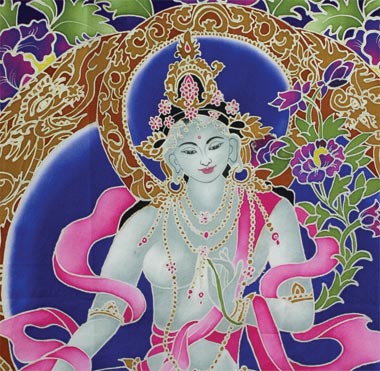
In the major religious traditions of humankind god is always used in the singular. In Judeo-Christian thought as in Plato as well in Islam, we find explicit affirmation of there being but one God. This firm belief in a single god is referred to as monotheism. On the other hand, there are (and have been)religious systems which freely recognize a variety of gods. In ancient Egypt,Persia, and Greece, for example, many different gods were worshipped. We call this belief polytheism.
In the vision of Hinduism there are no simple answers to complex questions. If we ask the Hindu tradition, which of the two views, a single god or many gods is correct, the answer would be, both: There is but one god, and there are also many.
Confusing as such an answer might seem, a little reflec-tion will show that it carries much meaning if we recognize that God is not an object or an entity that is to be spotted at some place and time, but an inherent feature of the cosmos that is to be grasped as an inner experience. We may approach the question through an analogy.
Consider music. Is there such a thing as music ? The answer clearly is yes, but only to those who have heard music. A person born deaf may deny the existence of music or at best agree with a hearing person who tells him so. But no one can intellectually grasp music: It is to be experienced, not defined. Now let us ask: Is there one music or many ? Music is one, but its expressions are countless. What is more, at least for most of us, we can only know music through its many expressions. Perhaps, at the highest level, one may be able to grasp music as such without reference to any particular piece. This, roughly, is the Hindu view of god. There is but one god, but its manifestations are many. And god is best experienced through one or more of its multiple manifestations.
It is possible to enjoy a variety of music and yet be fond of one particular piece more than any other. If we were to ask an avid music lover which is the most im-portant or enjoyable piece of music, she could very well say, "The one I am istening to at a given moment." For each piece has its own charm and beauty,and while one is in the joys of listening to a particular piece, all others recede into silence. So too, in the Hindu mode, of the many manifestations of god, the one that is being adored is the most important at the moment. Others may, at other times, take on the primary role.
In the Hindu attitude to the Divine, the one God is manifest in many different forms of co-equal importance, yet with one of them taking on major significance to an individual in a given context. Furthermore, just as every music lover may have his or her own favorite piece, a Hindu (or Hindu family) may have a favorite divine form; that is, One Who is worshipped regularly as one's own hereditarily adopted deity. Such a godhead is called an ishta-devata or chosen god. And we are told, pratim?rathamo pr?han?the m?is the first step in worship.
Monotheism is a grand vision, if the term only implied belief in a single God. Sadly, it often includes a constraining corollary: "That One God is the God which I worship." It is no small irony of history that there have been more bloody confrontations between monotheistic religions and among sects within monotheistic religions than between any of them and a polytheistic one: not a happy commentary on Middle-Eastern monotheism.
Theologians and leaders of all religions would do well to consider Hinduism's view on this matter. There is a precious aphorism in the Rig Veda which says it all:
ekam sat; vipra bahuda vadanti
Truth is one; the learned call it by different names.
The word sat means truth, essence, and also God. God is essentially the ultimate truth, the quintessence of the Cosmic Whole. In the Hindu framework, by truth one means that which is real, and by real one means that which is eternal, and not subject to transformation or decay. Thus, God is the only Reality with a capital R. Reality with a small r is the passing and perishing panorama that we experience every waking hour.
Quintessential Truth, however, is infinite, and it can be grasped only in parts and only parts of it can be grasped by the human mind. So every description of the Divine, whether from revelation or through speculation, whether from reading or by reflection, can only be partial. So we all proclaim it in many different ways. One is not right and the other wrong in this matter. Like the six blind men who wanted to know about the elephant, we all obtain a glimpse of the Ultimate. Truth about the Ultimate is like the glitter of a gem, it shines in different ways when viewed from different angles. For the enlightened heart and mind, God can be seen in the star of David as in the Cross, in the Crescent inspired by the Koran as in the abstract sound of the sacred Om.






